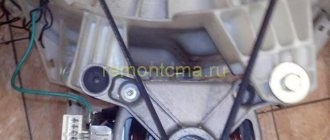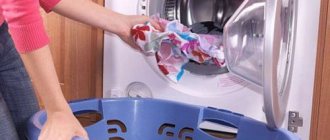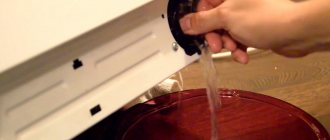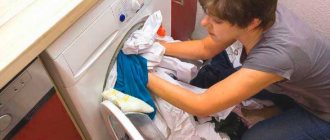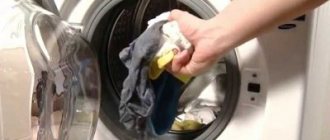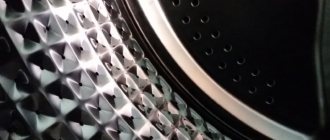When a washing machine does not wash well, this becomes a signal that the machine is faulty. There can be many reasons: from low-quality powder to technical problems. Some of them can be fixed on your own.
offers inexpensive, home-based repairs of washing machines. You can submit an application using the online application on the website or by phone number. Our employees work with equipment of all brands: AEG, Ariston, Whirlpool, Bosch, Hansa, Miele, Samsung, LG, Indesit, Candy, Ardo, Zanussi, etc. Repairs and replacement parts are guaranteed.
Causes of malfunction
Our experts have prepared a list of the most common reasons why a washing machine does not wash clothes well.
Wrong mode selected
Things remained dirty after the cycle ended.
Set a program that works well for your specific fabric type. On many things, manufacturers themselves indicate which mode is required (on the tags).
Economical consumption
This problem is more often encountered by users who purchased budget models. Such washing machines strive to save everything: powder, water. As a result, the fabric does not wash well.
The main symptom is white stains from the powder (the device saves rinsing liquid and does not rinse out the cleaning agent well).
If the owner does not plan to purchase a new device, there is only one way out - to load less laundry.
Overload
Stains remain on clothes and holes appear.
Due to the tight fit, things rub against each other. As a result, even new underwear remains scuffed.
Try not to load the machine to the maximum: in the instructions, the manufacturer indicates the permissible amount of laundry. Exceeding will result in damage.
Bad powder
It is worth noting that this is the most common source of the problem. Cheap gels and other cleaning agents will save money, but will not guarantee stain removal. In addition, they damage clothes: they fade, stretch and tear.
Buy cleaning products that have been tested or recommended by the manufacturer.
Dirty water
Traces of rust remain on the material, and the powder does not foam well.
If the source is a hard liquid, purchase special emollients from household chemical stores. An analogue is soda, just pour 1-2 spoons into the drum.
If the problem is an old plumbing system, contact your utility company.
Clothes are very dirty
If there are stains that are difficult to remove (fuel oil, oil, etc.), they may remain after washing. Even good stain removal products won't help.
If possible, set the maximum temperature - 90-95 degrees, this will enhance the effect of the powder. Important: before starting a cycle, make sure that this mode will not damage your laundry.
Also, before loading, rub the most contaminated areas with laundry soap.
Dirt inside the drum
After washing, the laundry turns out to be dirtier than before. Some things may smell unpleasant (musty). The reason is poor maintenance of the unit, as a result of which mold or other microorganisms appear.
Follow the operating instructions and care for the device.
- Rinse the tray, carefully removing any remaining detergent.
- Clean the water inlet hose.
- Periodically run an “empty cycle”: set the temperature to high and add special compounds to prevent contamination (they can be purchased in specialized stores).
- After each cycle, remove any remaining moisture with a dry cloth (pay special attention to the tray and cuff).
Broken heating element
The entire cycle takes place in cold water. This is easy to check: just touch the glass of the hatch 20 minutes after starting work at high temperature. If the glass is cold, you need to call a specialist to check the heating element.
It usually fails due to:
- scale formation;
- frequent power surges in the network.
Experts recommend changing the heating element every 5-6 years.
In case of minor breakdowns, the engineer repairs the heating element. But usually it changes to a new one.
Bearing failure
Traces of grease remain on clothing. Also, with such a problem, the rotation speed of the tank slows down.
The problem arises as a result of natural wear of parts during long-term use or due to mechanical damage.
Replacing failed bearings will help eliminate the defect.
Loose drum belt
The tank begins to rotate more slowly until at one point it stops completely.
It is impossible to restore the belt to its previous condition, so the technician replaces it with a new one.
All sources due to which clothes cannot be washed in a washing machine can be divided into two groups:
- user errors and improper care of the device;
- technical issues.
Most can be repaired yourself. But to troubleshoot problems that require intervention in the design, we recommend calling a service engineer.
Detergents
When washing in a washing machine, use only powders intended for use in automatic washing machines. They foam less than hand washing powders. The fact is that excess foam in the washing machine can damage its electrical wiring.
Linen is divided into four groups:
- Made from natural fabrics - cotton, light-colored, such as towels and bed linen. They are washed with universal powders. For bleaching, there are washing powders on sale that already contain bleach in their composition or have a wash enhancer (for example, stain removers). It is better to wash them at temperatures from 60 to 90 degrees;
- Colored - cotton underwear, mixed underwear, jeans, shirts. Such items should be washed with special powders for colored laundry. If you need to remove stains, you need to use bleach for colored laundry or a stain remover (wash enhancer). It is recommended to wash at 40 degrees;
- Delicate - washable only with special powders for delicate fabrics. If the manufacturer of the product allows washing at 40 degrees, this mode is optimal;
- Woolen items – it is preferable to dry clean such items. When washing yourself in a machine, you should use special liquid detergents for silk and wool.
Children's underwear should only be washed with products suitable for the age category the child belongs to.
You need to be especially careful with laundry detergents if there are allergy sufferers in the family. Fragrance or dust from washing powders causes an allergic reaction. In this case, you need to use liquid or fragrance-free detergents.
When using concentrated products, it is important not to violate the dosage, otherwise the residues will not be washed out of the tray and the washing machine itself, will remain on things or spoil them, leaving stains.
Washing powders and other products for use in washing machines contain substances that have a specific shelf life, after which their chemical and physical properties may change.
It is better to purchase powders and related drugs in intact and undamaged packaging, which should contain all the information about the substances they contain. You should not blindly trust advertising and buy only branded and advertised products.
More expensive does not always mean better, and there is no point in overpaying for a fashionable name. It is better to check the quality of washing yourself and use proven and reliable powders.
DIY repair
The user can eliminate defects not related to the technical condition with his own hands.
- Set the correct program to suit your clothing.
- Choose a good detergent (recommended by the manufacturer or time-tested).
- Soften the water to prevent failure of the heating element.
- Pre-soak fabric with stubborn stains or wash them with laundry soap.
- In rare cases, the user can independently replace the bearings or belt (if there is an understanding of the design of the device).
In all other cases, you must contact the service.
What to do if the washing machine freezes
Since today the models of washing units have become “smart”, problems associated with the computer responsible for the washing, spinning, rinsing and drying modes cannot be ruled out during their operation. If your machine does not stop, i.e. There is a failure in the program and it continues to constantly rinse the items loaded into it, then you need to turn it off.
In such a situation, you need to eliminate the electronics failure by turning off the unit from the network and independently draining the liquid from it through a filter or emergency drain. As a rule, the washing machine hangs on the rinse cycle because it is clogged, which prevents the normal passage of water. This problem can be resolved by cleaning the filter or replacing it. If everything is fine with the drain, then the reason lies in a malfunction of the control board, motor brushes, and even motor failure.
Preventive measures
To avoid problems with the quality of washing, it is enough to follow simple preventive measures. Our engineers have prepared several tips that will allow the unit to wash clothes well.
- Before loading, check the pockets: foreign objects may remain there and clog the drain system. As a result, the waste liquid will return to the device and ruin the clothes.
- Monitor the number of things you load: do not overload.
- Check the clothing care instructions: wash at the temperature indicated on the tag.
- Leave the door open after the cycle is complete to allow any remaining moisture to evaporate. Also wipe the rubber cuff with a dry cloth.
- Clean the filter and powder tray regularly.
If preventive measures do not help, things are difficult to wash, and you don’t know what the reason is, call the Remontano SC.
Machine contamination
If you suddenly discover that your laundry has not been washed well and has dark or rusty stains on it, check whether the problem lies in the condition of the machine itself.
The source of pollution can be:
- exfoliated deposits that have grown on the heating element;
- mold that appears on the inner walls of the tank and under the rubber seal of the hatch if the machine has not been used for some time and it has not been dried at the end of the last wash.
What to do in this case? Regular cleaning of the heating element with citric acid or special products, thorough cleaning of the sealing cuff, and rinsing the tank using a “idle” washing cycle with heating up to 90 degrees and using detergents will help get rid of this problem.
Some features to consider
The equipment from Beko is very conveniently designed, so replacing the same worn bearing is not difficult. Also, these machines are much easier to disassemble than equipment from other manufacturers. During repairs, most often you will not need to remove the tank; the components will already be available. You can only remove its front part, after which it will be possible to get the drum from the back, but the tank will still remain in the machine. Only if the bearing has completely become unusable and needs to be removed from the glass, you will have to remove the drum along with the tank.
To gain access to the front of the tank, you first need to remove the front panel and lower counterweight. Afterwards, you need to unscrew the tubes and wires from the tank. Before you disconnect all this, take a photo, especially of the soldered wires. By doing this, you can be sure of correct assembly.
The tank is secured at the front with 12 clips; they need to be removed. After which it can easily be pulled out. The bearings are seated very tightly on it, so it must be carefully knocked out, preferably with a rubber drum.
The screw that held the pulley to the shaft should not be used again.
No water coming in, too many things
If you put too much laundry in the Beko washing machine, more than what is allowed in the instructions, it will become more difficult for the machine to distribute the items over the surface of the drum. It will also not be easy for the equipment to “spin up” to the required speed. The program will start running, but it will take longer than usual. A batch of clothes loaded with a lump can also slow down the cycle.
It is important not to overload the Beko washing machine, carefully place the laundry in the drum, distributing the items evenly over the surface.
Another factor that results in longer wash cycles is the slow intake of water into the system. This situation can occur due to:
- low pressure in the water supply;
- not fully open inlet valve;
- clogged incoming mesh filter;
- intake valve defect;
- the inlet hose is clogged.
If the whole point is insufficient pressure, you need to wait until the water in the pipes flows with the same force. The blockage can be removed by cleaning; the intake valve will have to be replaced. Diagnosis should begin from simple to complex. First, check the water pressure, then inspect the shut-off valve, then inspect the inlet hose. Then you can go “deeper” - get to the mesh filter and solenoid valve.
Bad powder
This is the very first and most common reason. Special cleaning products are produced for automatic washing machines - powders with reduced foaming, as well as a high concentration of active ingredients.
When choosing a detergent, pay attention to the packaging. There should be a special marking on it - the powder is intended for an automatic machine. If the quality of your wash has noticeably decreased after you decided to experiment with different cleaning products, we recommend changing the brand - returning to the previous one or giving preference to a more reliable one. The amount of detergent for 1 wash cycle must correspond exactly to what is indicated in the instructions. On average, 1 tbsp. l. There is more than enough powder for 1 kg of laundry.
Important! Before washing, pre-treat heavily soiled areas of fabric with simple laundry soap so that you do not have to use additional functions of the equipment and thereby bring the time when the washing machine does not wash well.
The problem is in the heating element
The most common breakdown in which a washing machine does not wash clothes well is the burnout of the main working element - the heating element. A characteristic sign of this breakdown is that the water in the tank does not heat up.
The heating element can fail for two reasons:
- overvoltage in the electrical network;
- increased scale deposits.
Important! If the heating element malfunctions, the washing process at high temperatures cannot take place, and therefore, white linen takes on a shabby appearance and becomes dirty gray in color. If the problem is in the heating element, then call a technician who will find out the exact cause of the breakdown and fix it.
Too much water, no drain
The machine may take longer to wash than usual due to slow drainage. Therefore, noting that the work “slows down” precisely at the stage of removing water from the tank, it is necessary to inspect the elements of the drain system. The reason may be:
- Drain filter clogged. It is located at the front, at the bottom of the washer. Be sure to unscrew the element, wash it, clean the installation site and return the plug to its place;
- impeller failure. By unscrewing the garbage filter and shining a flashlight into the hole, you can see its blades. Roll them with a long stick. If the rotation is broken, the part will have to be replaced;
- clogged drain pipe. This is a tube that runs from the washer tank to the pump. The element will need to be cleaned;
- drain hose defect. Through it, the machine discharges water into the sewer. Often blockages form inside the cavity. Perhaps cleaning the hose will help. By the way, check that the drain hose is not pinched.
It’s not just the long drain that makes adjustments to the operating life of the Beko washing machine. The reason may be too fast, uncontrolled by the intellect, removal of water from the tank. This may be a consequence:
- incorrect connection of the unit. If the drain hose is simply thrown onto the floor, then the water will flow out of the tank by gravity. The “brain” will give the command to draw in liquid, and it will immediately flow back into the sewer. The cycle can drag on indefinitely. Check that the drainage hose is connected according to all rules, at a level of 50-60 cm from the floor;
- incorrect operation of the pressure switch. The sensor signals to the main module that the tank is full and it is possible to proceed to the next stage of washing. If the element is faulty, it can tell the “brain” that there is too much water. The liquid will drain, then the tank will fill again, and so on in a vicious circle. Replacing the pressure switch will solve the problem.
The washing time increases with slow drainage or, conversely, uncontrolled removal of water from the machine.
What to do in this case? You can repair the machine yourself. Even a beginner can handle cleaning the elements of the drain system. Replacing the pressure switch is also easy, the main thing is to follow the instructions.
Machine operating mode
The reason that the washing machine did not wash the clothes may be an incorrectly selected program. Choosing the economy mode when loading a large volume of items leads to soap stains remaining on the fabric due to poor rinsing.
Regular washing of clothes with the wrong mode leads to deterioration of the appearance and structure of the fabric. This is especially noticeable on white things - they turn gray and need to be bleached. How you can return the whiteness to grayed things, read the article at the link https://vsepodomu.ru/stirka/kak-vernut-beliznu-vescham/.
Formed mold
Sometimes, stains on washed items can be left by mold that has formed on the walls of the drum or on the sealing lip of the hatch. To prevent mold from appearing in the washing machine, periodically run the washing process in boiling mode. At the end of each cycle, be sure to leave the hatch door open for several hours until the drum is completely dry.
If mold has already formed, then carry out antiseptic measures or replace the hatch cuff with a new one (if necessary).



